Table of Contents
Disaster Management- Earthquakes, Floods, Landslides, Cyclones, Droughts:
Geological processes like earthquakes, volcanoes, floods, and landslides are normal natural events which have resulted in the formation of the earth that we have today. They are, however, disastrous in their impacts when they affect human settlements. Human societies have witnessed a large number of such natural hazards in different parts of the world and have tried to learn to control these processes, to some extent.
Earthquakes:

Earthquakes occur due to sudden movements of the earth’s crust. The earth’s crust has several tectonic plates of solid rock which slowly move along their boundaries. When friction prevents these plates from slipping, stress builds up and results in sudden fractures which can occur along the boundaries of the plates or fault lines (planes of weakness) within the plates. This causes earthquakes, the violent, short-term vibrations in the earth. The point on a fault at which the first movement occurs during an earthquake is called the epicenter. The severity of an earthquake is generally measured by its magnitude on the Richter Scale.
Earthquake-generated water waves called tsunamis can severely affect coastal areas. These giant sea swells can move at a speed up to 1000 km/hr or even faster. While approaching the seashore they may often reach 15 m or sometimes up to 65 m in height and cause massive devastation in coastal areas. In China, such waves killed 8,30,000 people in 1556 and 50,000 in 1976.
Anthropogenic activities can also cause or enhance the frequency of earthquakes. Three such activities identified are-
- Impoundment of huge quantities of water in the lake behind a big dam.
- Underground nuclear testing.
- Deep well disposal of liquid waste.
Management:
Damage to property and life can be prevented by constructing earthquake-resistant buildings in the earthquake-prone zones or seismic areas. For this, the structures are heavily reinforced, weak spots are strategically placed in the building that can absorb vibrations from the rest of the building, pads or floats are placed beneath the building on which it can shift harmlessly during ground motion. Wooden houses are preferred in earthquake-prone areas as in Japan.
Floods:
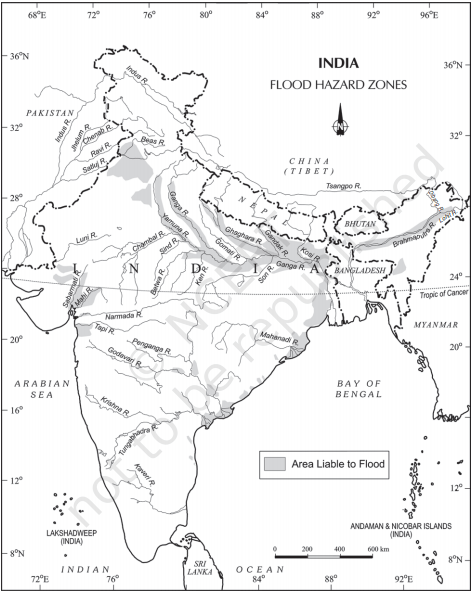
Generally the stream channels accommodate some maximum stream flow. However, due to heavy rains or sudden snow melt the quantity of water in streams exceeds their capacity and water overflows the banks and causes inundation of the surrounding land. This situation is called flood.
A flood generally doesn’t damage property or cause casualities to an extent as done by other natural disasters. However, it causes a great economic loss and health related problems due to widespread contamination. Virtually anything the flood water touches get contaminated, posing serious threat to health due to outbreak of epidemics.
Human activities have been the main causes for increasing the severity and frequency of floods. Construction of roads, parking space, and buildings that cover the earth’s surface hardly allows the infiltration of water into the soil and speeds up the runoff. Clearing of forests for agriculture has also increased the severity of floods.
Management:
To check the floods, efforts need to be made to restore wetlands, replace the ground cover on water-courses, build check-dams on small streams, move buildings off the flood plains, etc. Instead of raising buildings on flood plains, it is suggested that floodplains should be used for wildlife habitat, parks, recreational areas, and other uses, which are not susceptible to flood damage. River-networking in the country is also being proposed to deal with the flood problem.
Landslides:
Landslide occurs when coherent rock of soil masses move downslope due to gravitational pull. Slow landslips don’t cause much worry but sudden rockslides and mudslides are dangerous.
Water and vegetation influence landslides. The chemical action of water gradually causes chemical weathering of rocks making them prone to landslides. Vegetation consolidates the slope material, provides cohesion by its root system, and also retards the flow of water and its erosion capacity.
However, this can be masked by many other exerting factors like-
- Earthquakes, vibrations etc.
- Disturbances in resistant rock overlying rock of low resistance.
- Saturation of the unconsolidated sediments with water.
- Unconsolidated sediments exposed due to logging, road or house building.
Landslides are governed by the forces which tend to pull the earth material down slope (move in case of slopes with steeper slip plane) and resisting forces which tend to resist such movements.
It is difficult to control landslides. However, these can be minimized by stabilizing the slope by-
- Drainage the surface and subsurface water.
- Providing slope support like gabions (wired stone blocks).
- Concrete support at the base of a slope.
Cyclones:
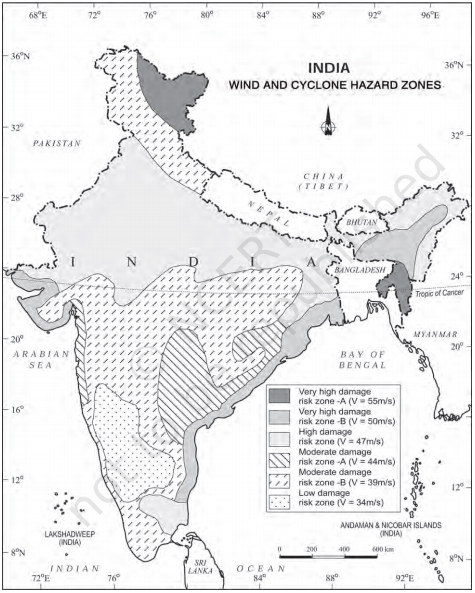
Cyclones are recurring phenomena in the tropical coastal regions. Tropical cyclones in the warm oceans are formed because of heat and moisture. One of the requirements for the formation of tropical cyclones is that the sea surface temperature (SST) should be above 26°C. Tropical cyclones move like a spinning top at a speed of 10-30 km per hour. They can last for a week or so and have a diameter varying between 100 to 1500 km. Since in the western parts of the main ocean no cold current exist, tropical cyclones originate there. Tropical cyclones are called hurricanes in the Atlantic, Caribbean, and northeastern Pacific; typhoons in the western Pacific; and cyclones in the Indian Ocean and willy willies in the sea around Australia.
More storms occur in the Bay of Bengal than in the Arabian sea. Of 5-6 storms that form in the year about half of them are severe. Hurricane winds (74 miles per hour or more), rains, and storm surge (often 50-100 miles wide dome of water) often devastate the area where it strikes on land. The devastation is more when storm surge and normal astronomical tide coincide. Seawater with combined forces rushes inlands and inundates the low lying areas.
Management:
It is difficult to stop the recurrence of cyclones. Some long term defence measures can help to protect us from devastation. Such measures include planting more trees on the coastal belt, construction of dams, dykes, embankments, storm shelter, windbreaks, proper drainage, and wide roads for quick evacuation.
Meteorological records of wind speed and directions should be kept properly so as to predict future cyclones and to make advanced preparations. In this regard, hazard mapping is very important.
Droughts:
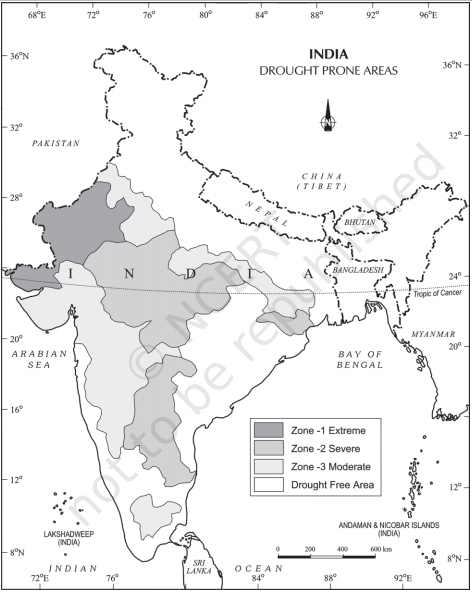
A drought is a prolonged period of acute shortage of water which can have serious effects on agriculture and other activities in the affected areas. It can lead to scarcity of water, food, fodder, and employment opportunities.
The condition of drought may occur either due to inadequacy of rainfall or the lack of irrigational facilities for meeting the normal crop requirements.
Types of Droughts:
Meteorological Drought:
It is a situation when there is prolonged period of inadequate rainfall marked with mal-distribution of the same over time and space.
Agricultural Drought:
It is also known as soil moisture drought, characterised by low soil moisture that is necessary to support the crops, thereby resulting in crop failures. Moreover, if an area has more than 30 percent of its gross cropped area under irrigation, the area is excluded from the drought-prone category.
Hydrological Drought:
It results when the availability of water in different storages and reservoirs like aquifers, lakes etc. fall below what the precipitation can replenish.
Ecological Drought:
When the productivity of a natural ecosystem fails due to shortage of water and as a consequence of ecological distress, damages are induced in the ecosystem.
Impact of Drought:
- Agriculture– It leads to the loss of crops. In a country like India, where the majority of people depend on agriculture, drought conditions can significantly reduce the agricultural production. This may lead to an increase in the prices of the products. As a result, poor people suffer more because they can’t afford to buy expensive food articles.
- Children and women– Reduction or loss in crops also leads to a reduction in income, which results in a lack of nutritional food for children and women in the affected areas. In rural areas, women are often denied their share of nutritional food, education, and health. They work longer and earn less. In the drought-affected area, they have to travel far to get water, fodder, and fuel-wood.
- Animal Husbandry– In rural areas, besides agriculture, people also depend on animal husbandry. Lack of fodder and vegetation cover during drought severely damage the animal population.
- Employment– Loss of agricultural output also leads to reduced employment opportunities for people involved in agriculture. This also leads to the migration of people to other areas.
Management:
Since drought is a natural phenomenon, it cannot be stopped. However, effective planning could make it easier to deal with drought and its consequences. The strategy to manage drought include-
- Close monitoring of the emerging drought scenario, so as to develop an advance warning system.
- Immediate relief measures for the affected population and the upkeep of the cattle wealth.
- Making alternative crop strategy for drought-prone areas by using drought-resistant varieties of crops.
- Additional employment should be generated in drought-affected areas.
- Promoting rainwater harvesting using traditional as well as modern methods with the help of local people.
- Make adequate arrangements for clean drinking water.
- Regenerating and restoring degraded lands. Degraded lands are lands that lose their crop-producing ability due to various reasons (such as soil pollution, soil erosion, and over-exploitation of land).

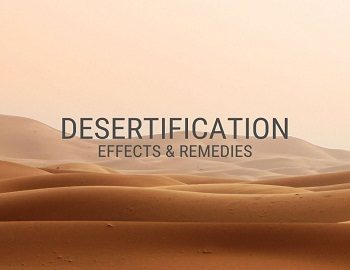




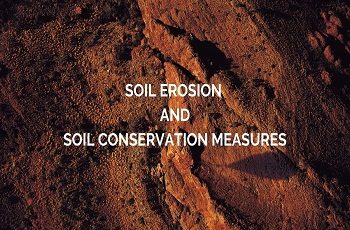
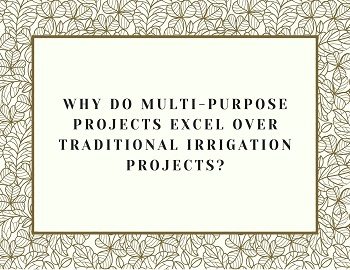

Comments (No)